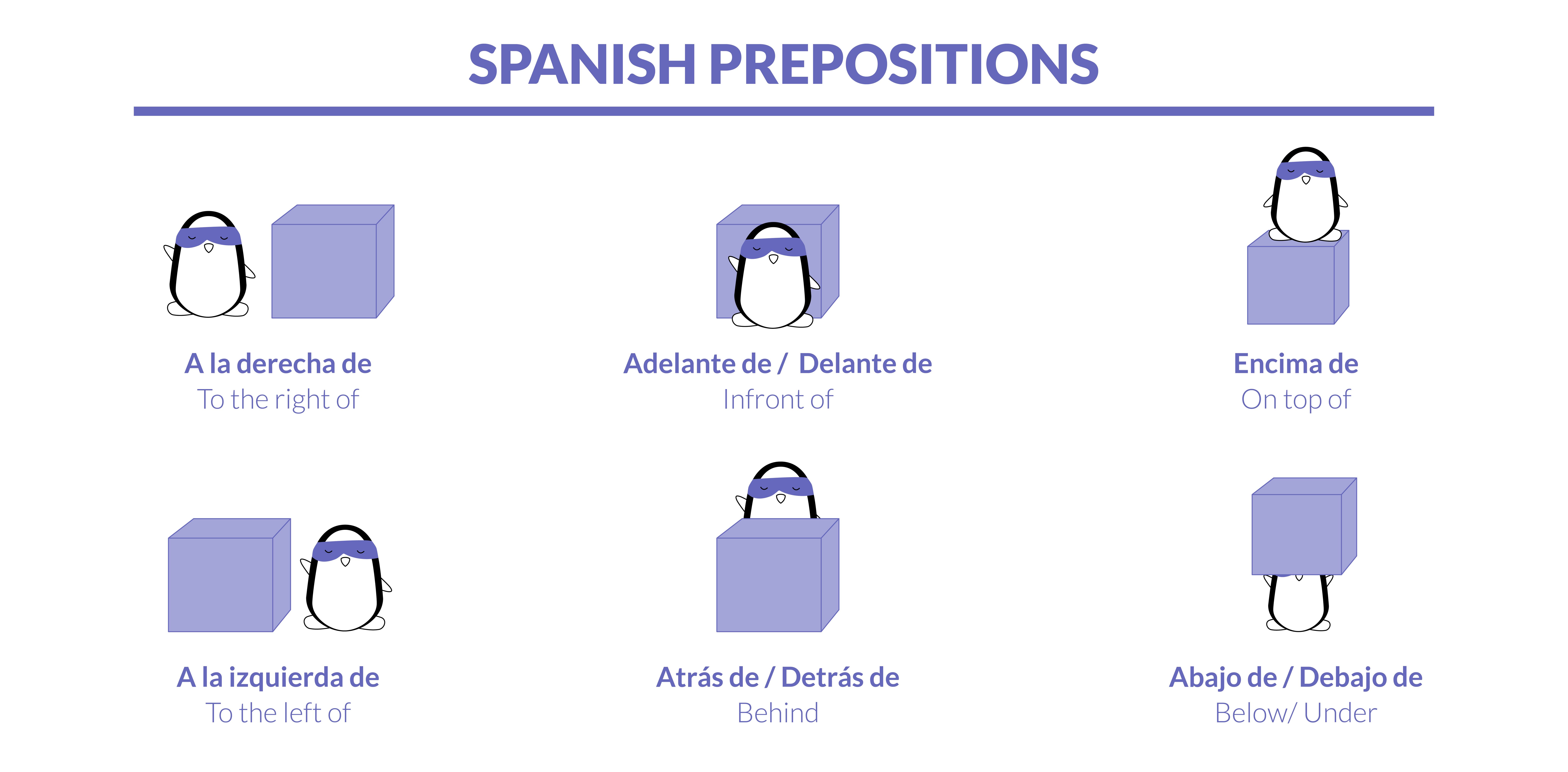
Spanish prepositions can often challenge English speakers trying to master the language. Unlike in English, prepositions in Spanish follow stricter rules and sometimes don’t have direct translations, making them tricky to use properly.
But, fear not! Understanding the different types and uses of Spanish prepositions will greatly enhance your ability to communicate effectively in Spanish — and we’re here to help!
From indicating location and time to expressing relations between objects or directions, prepositions are crucial connectors in any language. In this comprehensive guide, we'll break down Spanish prepositions by their uses, offering clear explanations and examples to help you learn the language just like native Spanish speakers.
Learn Spanish with Langster
Prepositions of Time
Time-related prepositions in Spanish are essential words. They allow you to discuss when something happens by denoting specific times, durations, and frequency.
These include terms reflecting points in time (e.g., at 5 o'clock), duration (e.g., for two hours), and other temporal relationships. Getting these right is key when making plans or talking about events.
| Spanish Preposition | English Equivalent | Example | Translation |
|---|---|---|---|
| A | at | Nos vemos a las ocho. | See you at eight. |
| En | on/in | Hablamos en la mañana. | We talk in the morning. |
| De...a... | from...to... | Trabajo de lunes a viernes. | I work from Monday to Friday. |
| Durante | during | Escuché música durante el viaje. | I listened to music during the trip. |
| Por | for | Estudié español por dos años. | I studied Spanish for two years. |
| Spanish Preposition | English Equivalent | Example | Translation |
|---|---|---|---|
| A | at | Nos vemos a las ocho. | See you at eight. |
| En | on/in | Hablamos en la mañana. | We talk in the morning. |
| De...a... | from...to... | Trabajo de lunes a viernes. | I work from Monday to Friday. |
| Durante | during | Escuché música durante el viaje. | I listened to music during the trip. |
| Por | for | Estudié español por dos años. | I studied Spanish for two years. |
Prepositions of Place

Prepositions of place give us an idea of where something is located or the direction in which something is moving. They can specify proximity (next to), direction (toward), and orientation (above, under), among others.
Here are the most common Spanish prepositions of place:
| Spanish Preposition | English Equivalent | Example | Translation |
|---|---|---|---|
| En/sobre | on | El libro está en la mesa. | The book is on the table. |
| En | in | Estoy en el cine. | I am in the cinema. |
| En | at | Estoy en casa. | I am at home. |
| Delante de | in front of | La mesa está delante del TV. | The table is in front of the TV. |
| Encima de | above | El cuadro está encima de la cama. | The picture is above the bed. |
| Debajo de | below | El gato está debajo de la mesa. | The cat is below the table. |
| Al lado de | next to | La casa está al lado de la iglesia. | The house is next to the church. |
| Entre | between | El banco está entre el supermercado y la biblioteca. | The bank is between the supermarket and the library. |
| Spanish Preposition | English Equivalent | Example | Translation |
|---|---|---|---|
| En/sobre | on | El libro está en la mesa. | The book is on the table. |
| En | in | Estoy en el cine. | I am in the cinema. |
| En | at | Estoy en casa. | I am at home. |
| Delante de | in front of | La mesa está delante del TV. | The table is in front of the TV. |
| Encima de | above | El cuadro está encima de la cama. | The picture is above the bed. |
| Debajo de | below | El gato está debajo de la mesa. | The cat is below the table. |
| Al lado de | next to | La casa está al lado de la iglesia. | The house is next to the church. |
| Entre | between | El banco está entre el supermercado y la biblioteca. | The bank is between the supermarket and the library. |
Prepositions of Motion
Motion prepositions in the Spanish language often work with verbs of movement, indicating direction towards a place, following a path, or moving in relation to a location. When you talk about movement or directions, you’ll need to use these prepositions to specify your path or destination.
| Spanish Preposition | English Equivalent | Example | Translation |
|---|---|---|---|
| A/hacia | to | Voy a la playa. | I am going to the beach. |
| Hacia | towards | Camina hacia la luz. | Walk towards the light. |
| Por | through | Paseamos por el parque. | We walk through the park. |
| Alrededor de | around | Andamos alrededor de la ciudad. | We walk around the city. |
| A lo largo de | along | Conducimos a lo largo de la costa. | We drive along the coast. |
| Por | by | Paso por tu casa. | I pass by your house. |
| Spanish Preposition | English Equivalent | Example | Translation |
|---|---|---|---|
| A/hacia | to | Voy a la playa. | I am going to the beach. |
| Hacia | towards | Camina hacia la luz. | Walk towards the light. |
| Por | through | Paseamos por el parque. | We walk through the park. |
| Alrededor de | around | Andamos alrededor de la ciudad. | We walk around the city. |
| A lo largo de | along | Conducimos a lo largo de la costa. | We drive along the coast. |
| Por | by | Paso por tu casa. | I pass by your house. |
Prepositions of Manner
The manner prepositions in Spanish are related to the way in which an action is carried out. These important Spanish prepositions are used to describe how something is done or to express conditions, means, or modes.
They offer details that paint a clearer picture of an action or situation:
| Spanish Preposition | English Equivalent | Example | Translation |
|---|---|---|---|
| Por | by | Voy por avión. | I go by plane. |
| Con | with | Escribo con lápiz. | I write with a pencil. |
| Sin | without | Viajo sin equipaje. | I travel without luggage. |
| Según | according to | Según el doctor, estoy bien. | According to the doctor, I'm fine. |
| En lugar de | instead of | Leo en lugar de ver la televisión. | I read instead of watching TV. |
| Spanish Preposition | English Equivalent | Example | Translation |
|---|---|---|---|
| Por | by | Voy por avión. | I go by plane. |
| Con | with | Escribo con lápiz. | I write with a pencil. |
| Sin | without | Viajo sin equipaje. | I travel without luggage. |
| Según | according to | Según el doctor, estoy bien. | According to the doctor, I'm fine. |
| En lugar de | instead of | Leo en lugar de ver la televisión. | I read instead of watching TV. |
Compound Prepositions

Compound prepositions (also called prepositional phrases) are formed by joining two more simple prepositions to provide a more specific sense of direction, location, or relation. These can be particularly tricky to learn and deserve extra practice.
| Spanish Prepositional Phrase | English Equivalent | Example | Translation |
|---|---|---|---|
| Junto a | next to | El estacionamiento está junto al banco. | The parking lot is next to the bank. |
| Enfrente de | in front of | La parada está enfrente de la tienda. | The stop is in front of the store. |
| Detrás de | behind | El jardín está detrás de la casa. | The garden is behind the house. |
| A nombre de | on behalf of | Firma a nombre de la compañía. | Sign on behalf of the company. |
| Encima de | on top of | El gato duerme encima de la cama. | The cat sleeps on top of the bed. |
| Spanish Prepositional Phrase | English Equivalent | Example | Translation |
|---|---|---|---|
| Junto a | next to | El estacionamiento está junto al banco. | The parking lot is next to the bank. |
| Enfrente de | in front of | La parada está enfrente de la tienda. | The stop is in front of the store. |
| Detrás de | behind | El jardín está detrás de la casa. | The garden is behind the house. |
| A nombre de | on behalf of | Firma a nombre de la compañía. | Sign on behalf of the company. |
| Encima de | on top of | El gato duerme encima de la cama. | The cat sleeps on top of the bed. |
How to Learn Spanish Prepositions
Get started with Spanish prepositions: understand their usage and grasp their nuanced meanings, so you can start using them in conversation with confidence and precision.
Practice with Visual Aids
In addition to memorizing Spanish prepositions and their English equivalents, make sure to include example sentences or phrases showcasing how each preposition is used in context.
For instance, pair the preposition a las with a picture of a clock showing 8 o'clock and the sentence Voy a la escuela a las 8 de la mañana.
Incorporate diverse visual representations to cover a range of time-related scenarios. For instance, use images of different types of clocks (analog, digital) displaying various times of the day or week and calendars highlighting specific dates, holidays, or events.
Interactive Visuals
Create interactive visual aids, such as digital flashcards or interactive presentations, where learners can click on each preposition to reveal its English equivalent and an associated example sentence. This interactive approach enhances engagement and facilitates active learning.
Include photographs or drawings depicting real-life situations where time prepositions are commonly used, such as people commuting to work, attending appointments, or participating in leisure activities. This adds authenticity to the learning process and reinforces practical application.
Multi-Sensory Approach
Consider incorporating auditory cues alongside visual elements, such as recording pronunciations of the prepositions and example sentences.
This multi-sensory approach appeals to different learning styles and reinforces both visual recognition and auditory comprehension.
Contextual Practice
Using Spanish prepositions in context is essential for developing fluency and proficiency in Spanish. Create more elaborate scenarios or narratives that require the use of multiple time prepositions in different contexts. For example, describe a typical day from morning to night, detailing activities and appointments using appropriate prepositions.
You can also engage in role-playing exercises with language partners or classmates where you simulate real-life conversations involving scheduling, making plans, or discussing past events. Act out scenarios like arranging meetings, setting deadlines, or planning vacations using time prepositions.
Participate in virtual role-play simulations or language exchange platforms where you can engage in conversational exercises that involve using time prepositions. Practice discussing schedules, arranging appointments, or recounting past experiences with native speakers or fellow learners.
Interactive Exercises
Interactive exercises provide dynamic opportunities to reinforce your understanding of time-related prepositions in Spanish. Explore language learning platforms and apps like Langster that gamify the practice of time prepositions through interactive quizzes, games, and challenges.
Look for features such as progress tracking, leaderboards, and rewards to enhance motivation and engagement, such as online videos, podcasts, or interactive tutorials that incorporate time-related prepositions in authentic contexts.
Follow along with guided exercises, pause for practice opportunities, and interact with comprehension checks to reinforce learning.
After completing interactive exercises, take time to reflect on your performance and identify areas for improvement. Review incorrect responses, analyze patterns of errors, and revisit relevant learning materials to reinforce concepts and improve accuracy over time.
Listening Comprehension
Enhancing your listening comprehension skills in Spanish involves actively engaging with spoken language to understand how prepositions are used in various contexts. Explore a wide range of Spanish audio content, including podcasts, radio programs, audiobooks, and online videos. Choose topics that interest you and contain natural conversations where speakers use prepositions in different situations.
Listen attentively to how speakers use prepositions to convey spatial relationships, time expressions, and other nuances in speech. Pay close attention to phrases that indicate location, movement, direction, and time frames.
Transcription Exercises
Challenge yourself by transcribing short passages or dialogues from Spanish audio sources. Focus on accurately capturing the prepositions used and their corresponding context within the spoken discourse. Compare your transcriptions with the original text to identify areas for improvement.
Practice repeating phrases or sentences containing prepositions after hearing them in Spanish audio recordings. This technique, known as shadowing, helps improve pronunciation, intonation, and overall fluency while reinforcing your understanding of prepositional usage.
Keep a Language Journal

Maintaining a language journal provides a structured opportunity to practice using Spanish prepositions in written form while documenting your language-learning journey.
Dedicate time each day to write in your language journal, recording observations, thoughts, experiences, and reflections in Spanish. Practice using appropriate prepositions by incorporating specific details about time, location, and spatial relationships.
Incorporate time-related prepositions into your journal writing practice by describing daily routines, reflections on past events, or future plans. Challenge yourself to vary the time frames and contexts to strengthen your proficiency in using prepositions accurately.
Explore creative writing prompts that imply the use of time prepositions in imaginative ways. For instance, write a short story set in a specific time period or create fictional characters with distinct schedules and routines.
Finally, it's a good idea to share your written compositions or verbal descriptions with peers or tutors for feedback on your usage of time prepositions. Collaborate on editing and revising exercises to refine your understanding and expression of temporal relationships.
Time-Specific Entries
Include entries that focus on describing your daily routines, activities, and events, paying particular attention to the time frames indicated by Spanish prepositions. Write about when activities occur, how long they last, and any temporal relationships between events.
Vocabulary Expansion
Use your language journal as an opportunity to expand your vocabulary related to time expressions and prepositions. Look up new words and phrases associated with time, duration, frequency, and temporal relationships, and incorporate them into your writing.
Self-Reflection and Analysis
Periodically review your journal entries to assess your progress in using Spanish prepositions accurately and effectively. Reflect on areas where you may need improvement, and set goals for further development in your writing skills.
Consider sharing excerpts from your language journal with language partners, tutors, or instructors for feedback and correction. Incorporate suggestions for improvement, and use corrected entries as learning opportunities to reinforce proper preposition usage.
Review and Reinforce
Consistent review and reinforcement are crucial for strengthening your grasp of Spanish prepositions and maintaining your language skills over time.
Set aside dedicated time each week to review the Spanish prepositions you've learned, including their meanings, usage rules, and common expressions:
- Use flashcards, mnemonic devices, or digital quizzes to reinforce your knowledge.
- Practice using Spanish prepositions in context through speaking, writing, and listening exercises.
- Create scenarios or prompts that require you to apply prepositions accurately in sentences, conversations, or narratives.
Integrated Language Practice
Integrate prepositional practice into your broader language learning activities, such as vocabulary drills, grammar exercises, and communicative tasks. Look for opportunities to incorporate prepositions naturally in your interactions and expressions.
When reviewing written or spoken language samples, identify any errors or inconsistencies in your use of Spanish prepositions. Analyze the context of each error, and make conscious efforts to correct and avoid similar mistakes in the future.
Progress Tracking
Keep track of your progress in mastering Spanish prepositions by monitoring your performance over time. Set measurable goals for improvement, such as increasing your accuracy rate in prepositional usage or expanding your repertoire of prepositional expressions.
Conclusion

In conclusion, while mastering Spanish prepositions can be challenging for English speakers, utilizing effective resources can make the process more approachable and enjoyable. One such resource is our Langster app, an interactive language learning platform designed to help you practice and internalize Spanish prepositions through contextual exercises and immersive storytelling.
By incorporating Langster into your study routine, you can accelerate your understanding of Spanish prepositions and make real progress toward fluency. So, take the leap, engage with Langster's rich learning environment, and watch as prepositions seamlessly integrate into your Spanish skill set.
Learn Spanish with Langster









